EA really stepped up their communication this year with a continuation of the Pitch Notes series. Promising updates to career mode, gameplay enhancements, and the introduction of the new mode Volta, it’s time to see if FIFA 20 lives up to hype.
What I Like
Pace of Play – This year, the pace of the game for FIFA 20 has been slowed to better represent what we see each weekend on our TVs. While the player movement has been slowed down some, other areas such as pass speed and the manner in which the AI attacks have been tuned accordingly. While the AI teams can be stagnant at times in attack, they don’t counter or break at the speeds they did in previous versions. They’re more calculated with their approach, even passing backwards, which in turn allows you time to set your defense accordingly. When it works, the ebbs and flows of a real match are represented fairly well. Furthermore, the AI teams will adjust their attacking/defensive mentality during career mode matches, which is fairly evident due to the increase in crowd noise (more on presentation shortly) and commentary hints, but you can really feel the difference in an organic manner as opposed to the heavily scripted feeling you would sometimes get in the past.
Dribbling & Physicality – Good dribblers such as Chelsea’s Willian take deft touches, allowing them to use their agility and pace to run at defenders even though at times it’s a bit overpowered right now due to the balance shift towards attacking (more on this later). Conversely, physicality has improved since the demo, and with the slower pace you’re able to fend off defenders or get into the attacker’s body if you’re defending. Bigger, stronger midfielders like Paul Pogba or Ruben Loftus-Cheek are harder to push off the ball, which can be a real advantage against pressing teams, especially if you like to try and control the tempo. One of the most important aspects to learn is the shield control (LT/L2) because it will really help you hold possession and allow for your AI teammates to either catch-up or find space, creating the outlets necessary to unlock defenses. AI dribblers like Sadio Mane will really dribble at you highlighting the emphasis EA has placed on 1-on-1 moments mentioned in their Pitch Notes series.
Even better, the AI players finally utilize the push-forward dribble command (flick RS forward for humans) as they bomb down the wings, something that they were incapable of last year.
Ball Physics – Look, the ball physics aren’t perfect, heading the ball in clearances showcases that they weren’t applied all over the game, but they are the best they’ve been in this series since FIFA 14.
Parried shots, deflections turning into 50-50 balls and first-touch control bring out the best in the ball physics. In addition, FIFA still has a fascination with shots ricocheting off the posts.
When you’re bringing a ball down from a pass with a little too much mustard on it, you’ll see the ball bobble a little bit and that helps to slow the pace down. These instances allow you to get the most out of some advanced instructions such as “Pressure on Heavy Touch.” One small but impactful change EA has implemented is that the ball indicator isn’t as precise, meaning that you can head or intercept passes mid-air
Shooting – Shooting has improved since FIFA 19 and is more realistic in terms of body position, what foot you’re on and user input (if not playing with fully assisted shooting). Holding true to a player’s ratings always matters in sports games, and I’ve really felt a difference between elite and average players in terms of accuracy. Timed finishing is still an option, but even with it disabled a nicely timed first-shot still has a large margin for error that forces you to alter your approach to shooting. Headers are toned down as it relates to accuracy. Having the “Power Header” trait really pays dividends as well, but the actual distance on headers can be very overpowered and needs to be toned down. The changes aren’t solely focused on the human-controlled players as the AI will shoot from distance with players such as Marcus Rashford — who peppered my goal with ferocious efforts. Even in preseason against inferior competition, it was good to see AI players shooting from distance.
Stamina Effects – One of the better under-the-radar tweaks EA Canada made was to stamina. Whether it be in exhibition, career mode or Pro Clubs, stamina has a much greater impact than before. Clubs who employ a “Team Press” will find that their players will tire at a more rapid pace, usually around the 65th minute they will slow down and are much more susceptible to injuries. Online, especially in Pro Clubs as you start with lesser stamina ratings, really makes the matches interesting during those stressful moments trying to either kill a game off or go for the win/equalizer.

The iconic George Best proudly displayed at Old Trafford
Presentation/Graphics – Presentation, as expected, is top notch, especially in those leagues that have the authentic broadcast packages. EA has nearly every Premier League stadium down to all its intricate details barring accurate ad boards. Swipes, overlays and stats are still impressive as they’ve updated them to reflect new TV presentations.
Additionally, some of the FIFA Ultimate Team (FUT) overlays such as the large team icons displayed pre-kickoff and after goals have migrated over to other modes, which is nice touch. Even within career mode the interactive videos within the main hub are well done. Commentary is up to its usual solid standards with Derek Rae — who I like — generally quick in keeping up with the action. He also mostly makes up for his partner Lee Dixon, who usually comes off as a commentator reading a script. FIFA mainstays Martin Tyler and Alan Smith are the primary team and it’s nice that FIFA offers a little variety when it comes to commentary.
FIFA 20 is a good looking game from a distance and up close. Player reactions to different events seem more natural, leading you to moments that can connect you to your game; Ross Barkley misses a sitter (of course, it’s not my fault) and we both have our hands on our head in disbelief. In motion, the kits look detailed and player faces look pretty good — I’m sure once the game is officially released all of the transfers, new faces, etc. will update (they weren’t at the time I was playing). Sometimes you forget how good FIFA 20 can look because most of us probably play on the default camera, which is zoomed out a lot. On broadcast cam, which I admittedly struggle with at times, the game has fooled my wife once or twice (hope you’re not reading this).

The Little Things – Every year there’s a thread in most of our AAA game forums called “The Little Things Thread” where posters highlight nice little animations that don’t necessarily impact gameplay but help to add immersion and emotion into games. Perhaps it’s time for one to be to be created in the FIFA forum because FIFA 20 does a great job at this. Little things like Tammy Abraham’s reaction to a pass he thinks he should have made.
Or the emotion by three-time fist pumping champion Jurgen Klopp:
Volta
Admittedly, I wasn’t too thrilled when Volta was announced, even with being a FIFA Street fan back when the franchise was still around. The demo did little to convince me, but once I had the opportunity to play the live version I found myself really enjoying the action. Yes, it’s super fast, full of tricks, cheesy cutscenes and other minor irritations, but the variety in backdrops, customization options, and generally fun gameplay changed my mind.
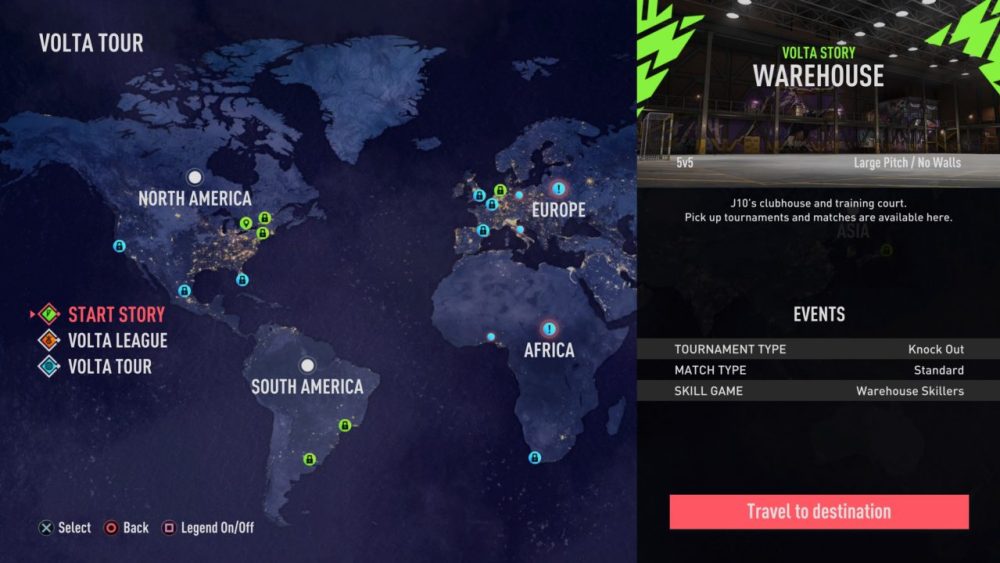
With three different options on how to play Volta inside the main mode (there’s an option for kickoff as well), there’s some fun to be had as you traverse the globe taking on created characters ranging in skill and ability as you level up. After your initial tryout, you’re invited — to be honest, not sure what happens if you bomb in the tryout — to join up with a squad that you can fully outfit in casual and sponsored gear (I’m sure more customization options will go live once the full game drops). I found myself accessorizing my character to the tee. Besides, “look good, play good” right? The story mode seems very Journey-like as you’re guided through cutscenes and scenarios that can change depending on your responses.
As you get better and your overall increases, you unlock more locations, but for now I started in the States and traveled to Miami. Here I could play in a four-round knockout-style tournament or a pickup game. With different sites having different settings (walls/no-walls, 5-on-5, 3-on-3, smaller/bigger pitches), you can also select the difficulty you play on with Volta coins (Volta’s currency), earned when you win your challenges (as you increase in difficulty you can earn more Volta coins). Volta coins can in turn be used to purchase additional customization options, but it’s yet to be seen if this mode incorporates microtransactions.
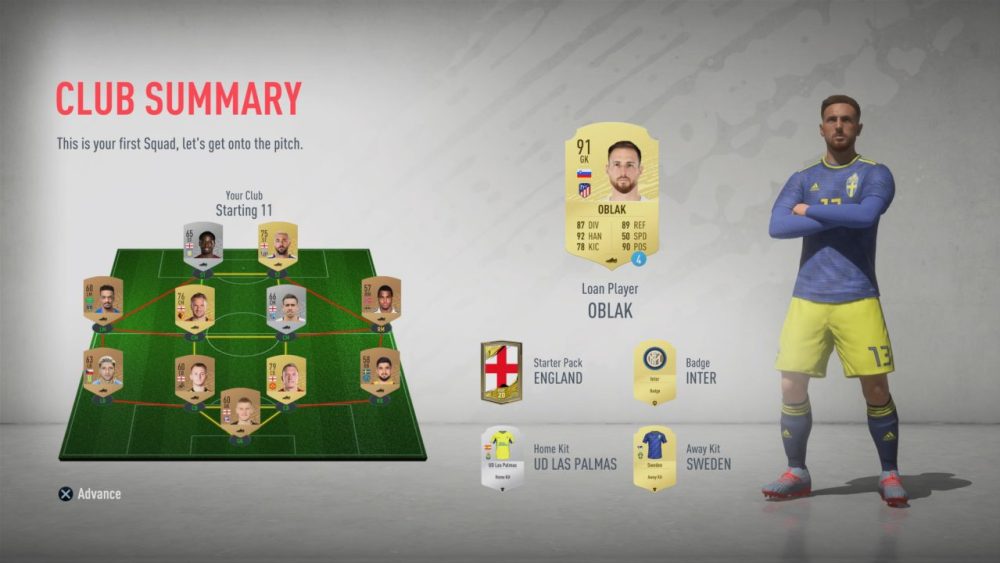
FIFA Ultimate Team (FUT)
FIFA Ultimate Team is back and is deep as ever, featuring some tweaks to the user interface (UI), and a host of new idols including two of my personal favorite all-time players in Zinedine Zidane and Didier Drogba. Then you throw in two legends of Serie A with Kaka and Pirlo, and those are some pretty big names in the world of footy. I’m far from a FUT expert, but the mode intrigues me as it appeals to my youth (card collecting aspect), my adulthood (the card trading otherwise known as the stock market), and the present (online gaming).
During my brief trial with it, I constantly found myself thinking that some features would slot nicely into career mode or Pro Clubs. Team Chemistry in FUT always makes the CM side of me jealous as it’s such a simple concept to implement but could go such a long way in CM. Learning about these concepts through the Foundations Objectives was easy enough. You can learn these things but there’s still the grind of FUT with team building, which to me is just as much as fun as playing the actual game. But what ties everything together are the enhancements to the UI, specifically the new Season Objectives hub, which is simplistic enough even for a FUT noob like myself yet straightforward enough for veterans of the mode to appreciate.
All of the different Objective options (Daily/Weekly/Season/Dynamic) are enough to keep you engaged throughout the season, earning XP along the way through varied rewards (packs, players, customization options and so on). Customization is strong across the entire FIFA 20 offering, and FUT is no different as you can customize your stadium themes, balls and Tifos. If FUT is your cup of tea, or you’re interested in getting a better understanding, be sure to check back with OS’ own Joe Doyle as he rolls out a series of FUT-related articles, starting with a beginner’s guide that can be found here.
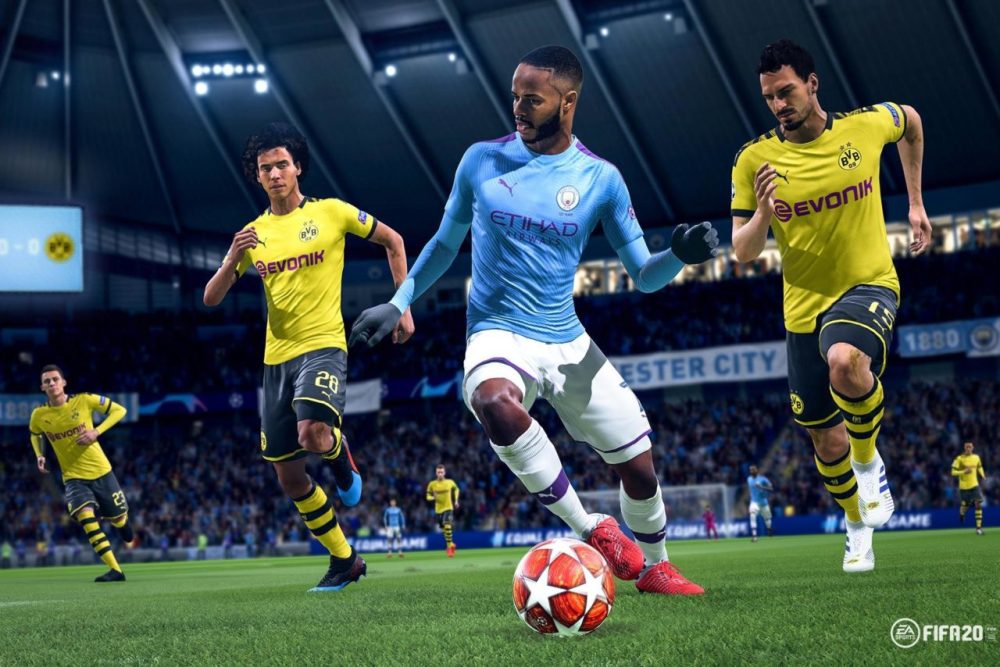
What I Don’t Like
Everything That Relates To Tactical Defending – As a loyal Mourinho fan, there is nothing that makes me cringe quite like poor defending, and FIFA 20 is one of the worst offenders when using Tactical Defending. The amount of head-scratching moments I’ve seen throughout my games, without even analyzing every build-up or defensive scenario, is shocking at times as it infiltrates nearly every mode except for Volta. Nearly every kind of defensive mistake you could make rears its ugly head.
For one, here are some instances of the dreaded defender stutter animation:
Here in the midfield, we have players just watching the play instead of doing their part.
We also have my center back taking his turn watching.
Here is the left-back getting in on the Watch Party.
To probably the most glaring issue with FIFA 20, the constant containing without putting in a challenge to the point of even backing off.
Simply put, it’s unacceptable for a game of FIFA 20‘s magnitude to release in such a state. 1-on-1 battles and “enhancing the skill gap” between players was a point of emphasis by EA, but to what detriment as this simply forces you to have to control nearly every play on the ball. Sure, the teams do a decent job at keeping their shape and they will stick out a foot to close down passing angles, but today’s football at the top level is mostly about team pressing. So at some point, whether you’re Man City or the Chicago Fire, conceding space to the point where attackers can dribble into your 18-yard box is not even close to logical defending.
Odd AI Moments – When it comes to attacking, the AI teams for the most part are fairly decent with their varied attacks and direct philosophy. They’ll take space when it’s given, push up the flanks, send in crosses and shoot from distance, but there are times when they become stagnant and don’t make runs. I’ve even seen instances, after kickoff, where they seem to be asleep and take a few seconds to wake up before jogging into position. Other times, when I’m containing, they will become extremely passive.
Or they will just completely ignore the ball:
Team tactics via instructions and slider adjustments can help inject some urgency in your teammates, but that should not have to be the solution. Your players and those on the other side should be able to carry out the most basic of soccer fundamentals — find space/close space down, and when the ball is in your area then you react. FIFA 20 really struggles with both of these.
Teams Playing Above Their Ratings – There are still matches within your career mode where, say, a Sheffield United club who might be sitting near the bottom of the table on terrible form, will come to your stadium and play like a peak Pep Barcelona side. Conversely, you’ll get the occasional top of the table clash with Real Madrid and they will play like a league two side. It’s odd, random and most likely a victim of deeply coded scripting, but whatever it’s attributed to needs to go. With no chemistry rating inside of career mode, you’re occasionally subjected to the AI’s mercy when it decides to go from relegation pushover to European dynamo.
Dr. Jekyll/Mr. Hyde Matches – There’s a bit of bipolar syndrome going on with FIFA 20 and it’s a little maddening. There are times where I honestly feel like I’m playing FIFA 19. The way the ball moves, how attacks come together and even animations appear all-too-familiar, but then there are other times when it feels like FIFA 20 comes together as it was marketed as. The pace feels good, the AI is patient — going backwards to go forwards — and the game sparkles, but it’s a coin toss as to what experience I’m going get. Even my beloved Pro Clubs, which initially gave me an incredible experience with slowed down pace, weightier players and intelligent AI teammates, has given me the opposite feelings at times when it becomes plagued with legacy FIFA 19 Pro Club issues, namely the easily exploitable AI.
Fouls? – Where are they? As I’ve become better at strafe dribbling, shielding and more comfortable with the game’s mechanics, I’ve been able to feel more confident drawing defenders in on the ball, but I’ve still gone matches without even seeing a foul called. With a new free-kick system it would be fun to actually get one every now and then.
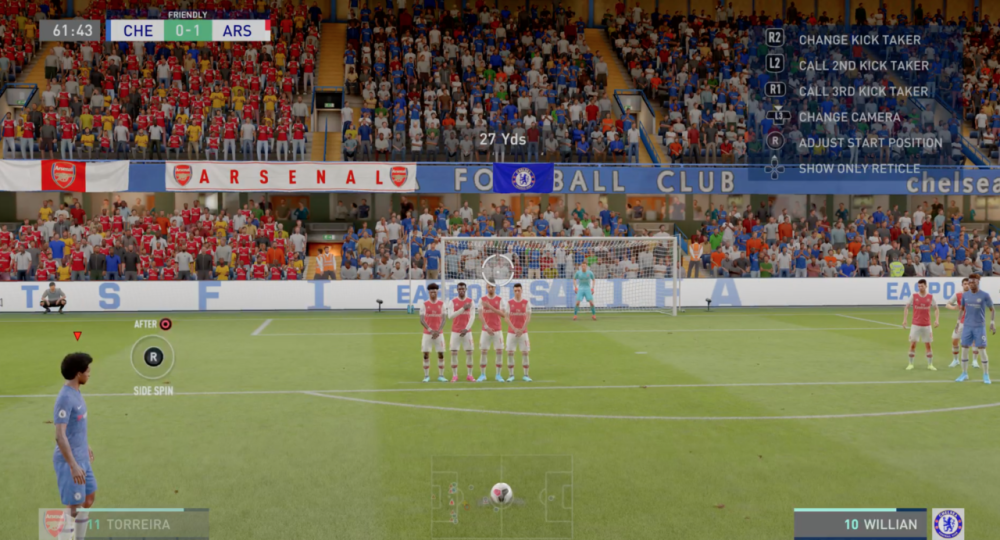
The collision animations are there as evidenced here:
Just as dramatic as Otamendi is in real life, but even when these interactions do play out the infraction often goes missing. With stamina more important this year, fouls and stoppages are very helpful at replenishing stamina, changing tactics on the fly and regaining your shape, but unfortunately it seems that EA doesn’t think they’re an important part of the game. It’s a shame because fouls have been implemented well in the past before patches totally removed them from the game.

Career Mode
This is finally the year that career mode was supposed to get some love, but unfortunately it’s a letdown once again. Instead of implementing community requests such as a practice arena, we’re greeted with more RPG-like interactions. Don’t get me wrong, those are needed as well, but here they’re more cosmetic than well thought out.
Upon starting the mode, you’re able to customize your manager using several pre-existing models, a few of which are women which is a nice touch. With updated clothing options from this decade, you’re actually able to see your created manager on the touchlines, in pressers and other various interactions through the season aimed at creating a connection between you, your club and the outside pressures that so frequently doom top-flight managers. However, this is where things start to fall apart. As with any job, you’re immediately faced with objectives — basically your expectations for the upcoming season — and while a few of them were reasonable for me in my Chelsea career mode (CM), some still should not have been placed at the feet of the manager. In this case, I mean things like “shirt sales” being my responsibility.
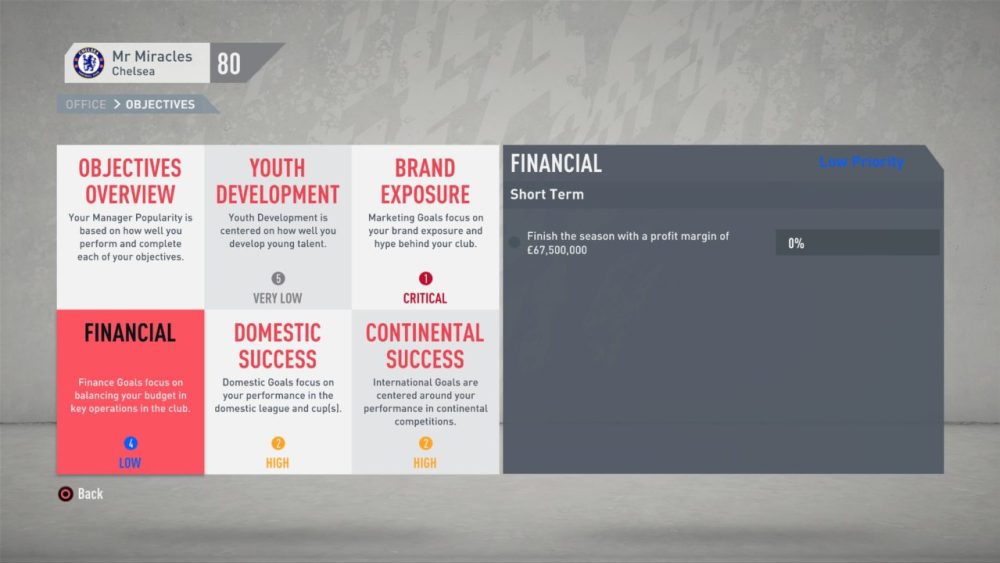
Believe me, there’s enough going on during your CM without having to worry about generating revenue for the club — surely something that’s the responsibility of a club executive.
Once your objectives are set and you progress past the preseason tournaments, if you chose to participate, you’re right into Squad Management duties like hiring youth scouts, setting up training and tinkering with your team sheets. Transfer business might also be available, but I chose to disable it for the purposes of keeping the rosters somewhat accurate during this review simulation.
Squad management is now based upon managing player and squad morale, mainly through interactive text messages. At various points through the season your players will text you, either asking for something (playing time, contract extensions, etc.) or voice their frustration over not playing. While man management is most certainly a part of being a gaffer, the interaction is all one-way with no ability for you to engage a player who might be suffering from poor morale. As I tinkered with lineups, poor Jorginho was unhappy with his playing time, eventually handing in a transfer request. Unfortunately, with a squad as large as Chelsea’s (since a lot of the transfers weren’t implemented at the time), I found it very difficult to keep the entire squad happy until I was able to see off some dead weight in January (more on the transfer market shortly).
While it’s a neat touch adding in player personalities, a few messages from different players were exactly the same, just coming from a different player as if it was some sort of group text. Player morale is mostly represented through smiley/frowning faces in your Team Management/Team Sheet screen, but if you go into the “Squad Hub” you get a better idea of what affects morale. What’s in the hub I would consider pretty spot-on if I were a player (player/team performance, wages/contract situation and playing time). If a player is suffering from poor morale, his ratings do suffer a bit, which is realistic in the sense that a lack of minutes can result in not being quite match fit. However, not being able to influence morale apart from player-initiated texts and press conferences makes man managing a tough gig.
Press conferences, both pre- and post-match are a nice little touch as you must go up to mic and address the press.
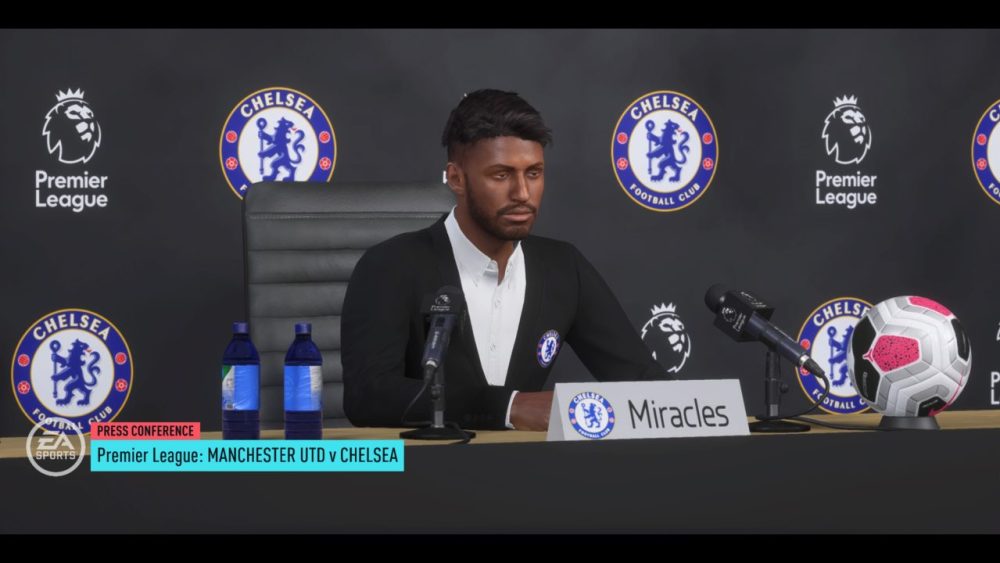
While the answers to most player-specific questions are very obvious, it’s nice that they’re tied into the Player Morale system and Season Objectives for you as a manager.

Mr. Miracles addressing the press after a disappointing 0-1 away defeat to Manchester United to open the campaign.
Whether or not these interactions will be become stale and quickly skipped (you can skip certain pressers) remains to be determined, but for right now it’s still a nice addition in need of a bit of logic tuning. I would love to see EA incorporate a man of the match presser in upcoming years as too little emphasis is put on this award.
Once you get past the cosmetic additions to CM, you quickly realize that EA has failed to address several key areas — where is the opponent scouting option or team form? — while somehow managing to mess things up that worked well in the past, namely sims. As I entered into the January transfer window, there was still plenty of business to be done as players agreed to transfer/loan deals early, meaning that once January 1 hit they would be off your books. Unfortunately, once they’re off your books, you cannot see if they’re actually playing matches unless you loan them to a club in your league. Imagine loaning out your promising youth academy prodigy to the English Championship and not being able to see if he’s getting minutes there apart from Cup action.
Once the market opens, things get a little crazy. Clubs within the league are fairly active in the market and CPU roster management seems better. No longer will you see Man United with 10 strikers on their roster, but negotiations and approaching another club raises some eyebrows.
As your scouts shortlist and scout players, you’re kept abreast of their ratings and value through messages — same as previous years — although for some strange reason EA removed the triangle icon (on PS4) that quickly takes you to your message. One of my scouts came with Manchester City’s Gabriel Jesus, a Brazilian international and current deputy to Sergio Aguero. No issue here as Aguero continues to bang in goals, meaning that at some point, Jesus, Brazil’s number 9, will want more minutes. What caught me off-guard was his value:
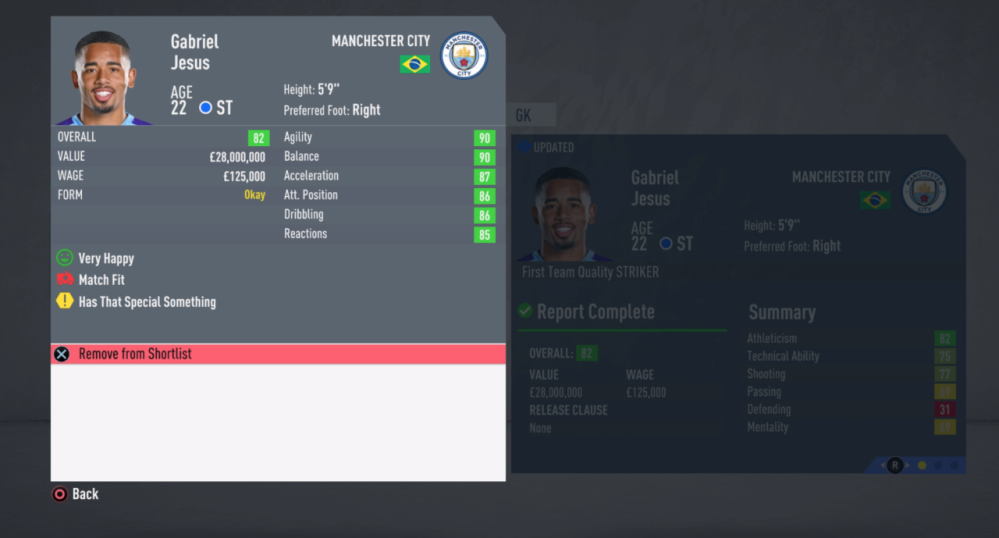
Twenty-eight million pounds for a striker of his current capability and potential is very low, especially when you can search online and see that his value is ~60-80 million pounds meaning that you’ll have to come with a decent offer if you want to pry him away from Manchester. Transfer values, even for those players who made moves this summer, are low across the board, a problem that didn’t exist for most of the well-known players in FIFA 19.
After identifying Jesus as my new #9 (sorry Tammy, I know you’re banging in goals in real life but sadly you’re still a 76 OVR in my build), I approach Man City to negotiate a deal and am ushered into a cutscene with Mr. Pep Guardiola making an appearance in my office.
OK, it’s cool seeing Pep and his Friday business casual attire, but since when do managers, especially Pep whose clubs tend to have no financial restrictions, engage in the actual negotiations? After coming in for Jesus with a reasonable 40 million pound offer I was hard-balled for… 41.4 million pounds. Man City is certainly not struggling for cash, but oh well, he was on his way to London, pending agreeing to personal terms (wages/contract).
Currently on 125K a week, Jesus and his agent led the negotiations. Well, Gabriel you need to fire your agent ASAP because he asked for 92K a week. Yes, that’s right, a player who wasn’t transfer listed or even unhappy, willingly took a cut in pay at Chelsea. Odd, but oh well as it saved me some funds. Apart from Jesus moving, there were a few big deals in January but nothing that would really move the needle — very similar to the past few January windows in real life. Sadly, there’s still no wrap-up report in January to see all of the comings and goings despite there being one for the summer window.
After simulating through the rest of the season, playing drop-in matches here and there, I finally made it to the end of season and here’s where things took another turn for the worse. Introducing your EPL title-winning Norwich City Football Club.

Yes, that’s right, that’s Norwich, recently promoted to the EPL, winning the title while leading wire-to-wire. My beloved Chelsea finished eighth, which promptly saw me terminated with a match to play. Yes, the ability to turn off firings is still not in the game, but a Top Four of Norwich and Newcastle? Man City losing 11 matches in the league, Liverpool drawing 15 matches and 62 goals by Norwich leading the league. For verification, last year Man City and Liverpool finished above 90 points with both clubs scoring more than 89 goals each. Last year’s real table was definitely an outlier, but in comparison, six teams scored more than 62 goals last year.
This means that your league leaders in goals for this sim were going to have low individual totals.

Year 1 Goal Leaders – EPL
Thankfully, two more test sims produced more realistic winners:
Perhaps it’s a one-off with Norwich, but seeing a side like Man City consistently finish closer to 8th than 1st is odd, even more with Newcastle having two top-four finishes.
Digging a little deeper, the low goal totals display the poor sim logic in your league, and finding out that the AI rotates keepers should point towards higher expected goals because you’re facing lesser-rated keepers.
Even though you can still not see player or team stats from other leagues, the simulations looked good with Barcelona besting Liverpool in the Champions League Final, while Juventus won the Europa League after crashing out of the Champions League group stages. On the domestic side, Arsenal took home the FA Cup while their London rival Spurs captured the Carabao Cup.
Lastly, it’s worth noting that “dynamic potential” seems to be a good addition as young players who I gave a significant amount of playing time to (Mason Mount and Callum Hudson-Odoi) each progressed between 4-5 points overall (without too many training sessions). In fact, even veteran Ross Barkley improved two points after seeing increased minutes following a January fire sale. What’s yet to be determined is whether or not dynamic potential applies to CPU-controlled teams and players. My suspicion is that it is not, meaning that if you buy the next phenom who has been loaned out or gotten minutes, his potential will be static until he joins up with your squad.
When it’s all said and done, FIFA 20 career mode is a big letdown, especially after a promising read of the Pitch Notes Career Mode Deep Dive.
Areas that were solid last year (transfer values, sim stats, etc.) have regressed while items promised to be fixed (improving the algorithm used by AI teams to determine their starting XI) are still broken. Realistically, I cannot see EA patching in a more intuitive two-way messaging system this year or any new features the community really desires, but they should be able to at least tweak the ability for the CPU to start stronger squads.

Bottom Line
Out of the box, FIFA 20 is the one of the poorest releases for the series in some time. The gameplay can’t get out of its own way at times due to poor defensive fundamentals, while the career mode is littered with bugs that were fixed in past iterations. Volta appears to be the only mode without major issues because the gameplay there is expected to be different. FIFA is always prone to patches (for better or worse), so if you’re on the fence be sure to keep your eyes open as this game will definitely change during the course of the season.


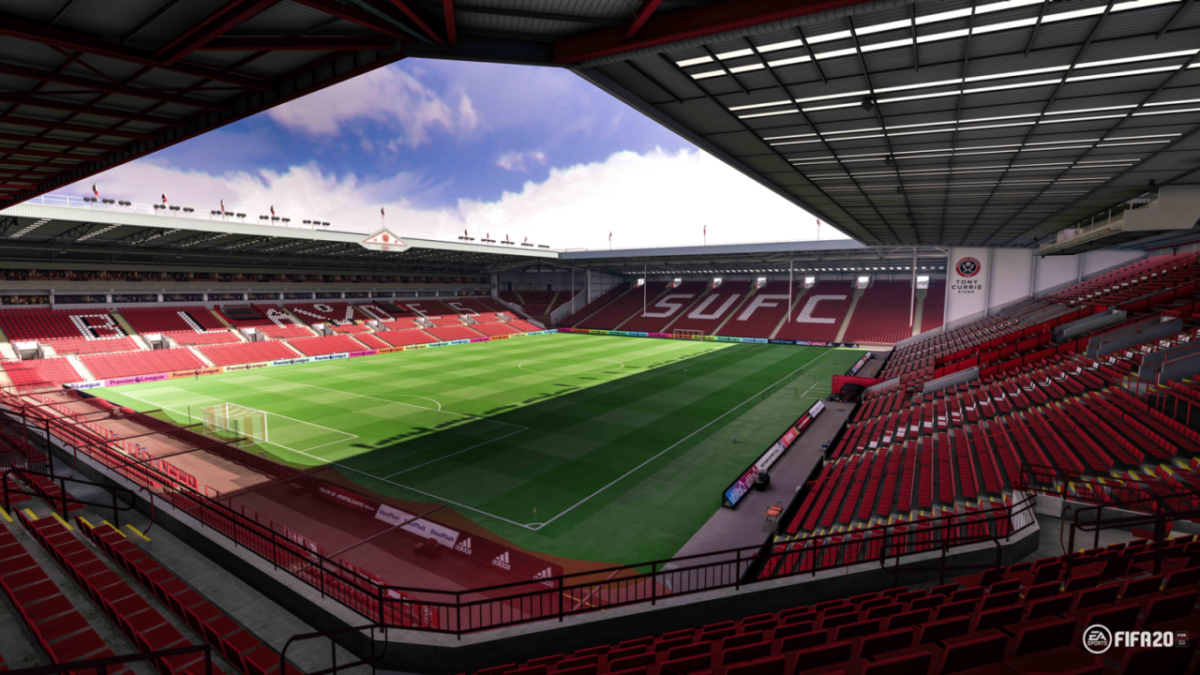


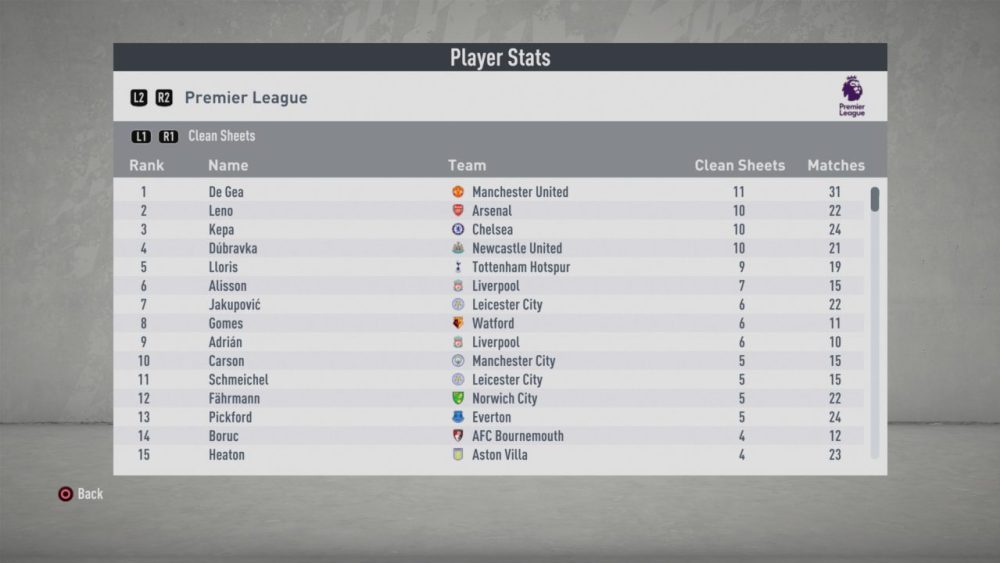
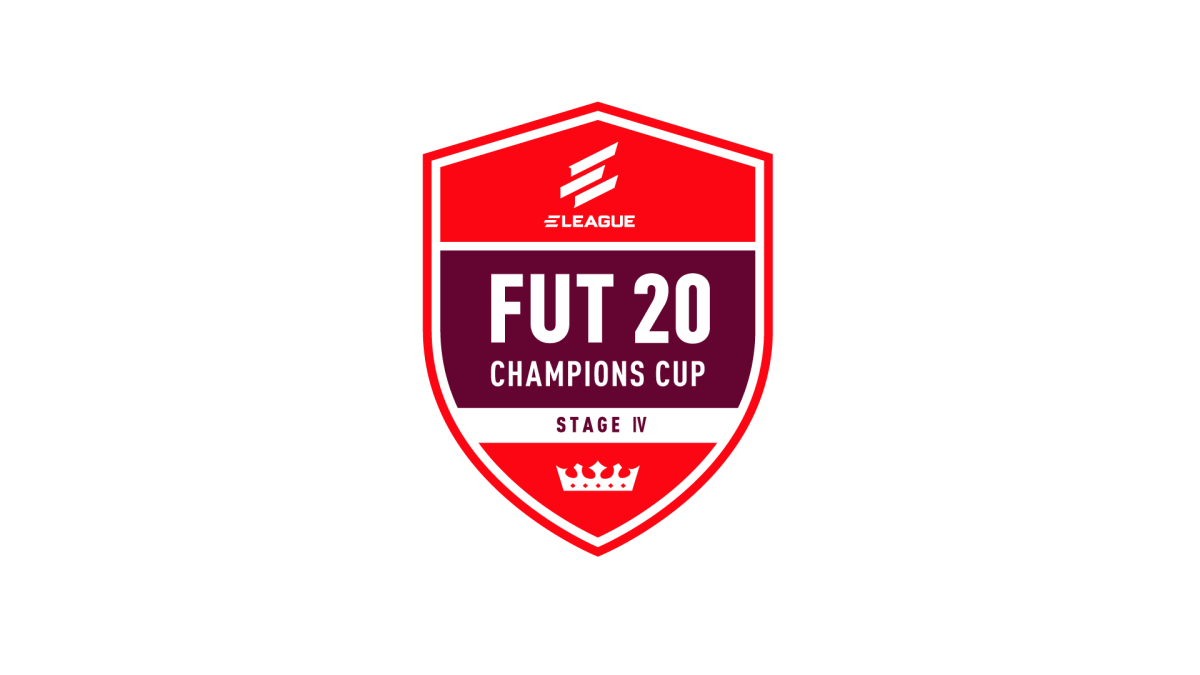
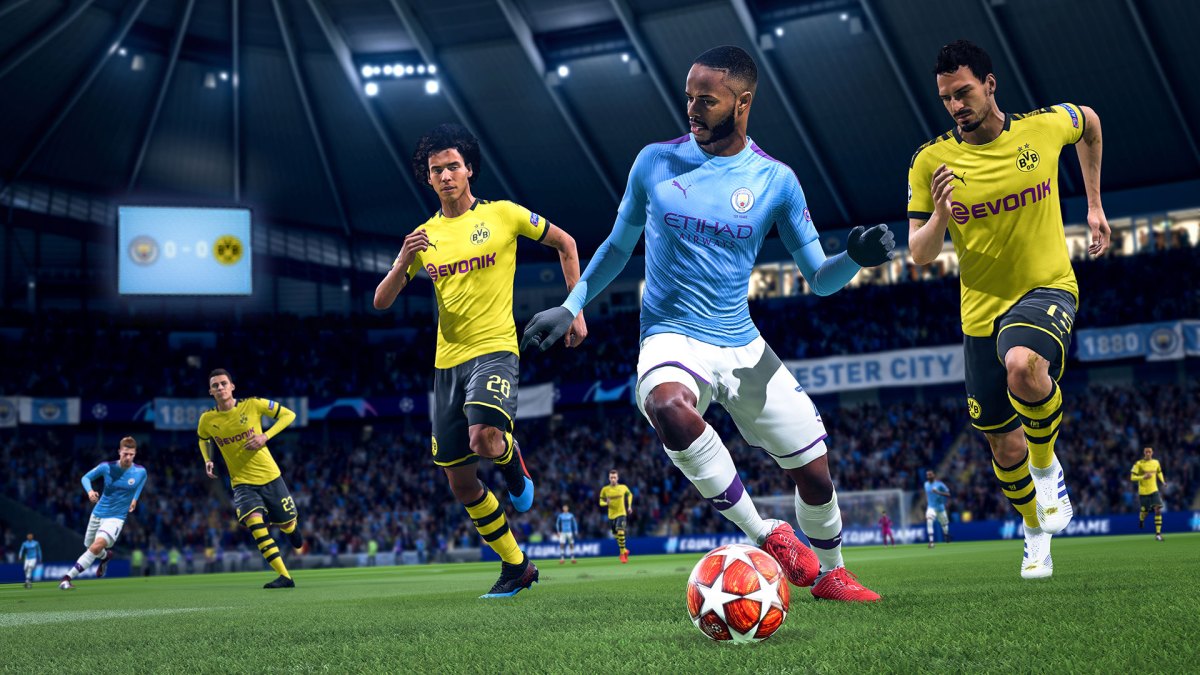
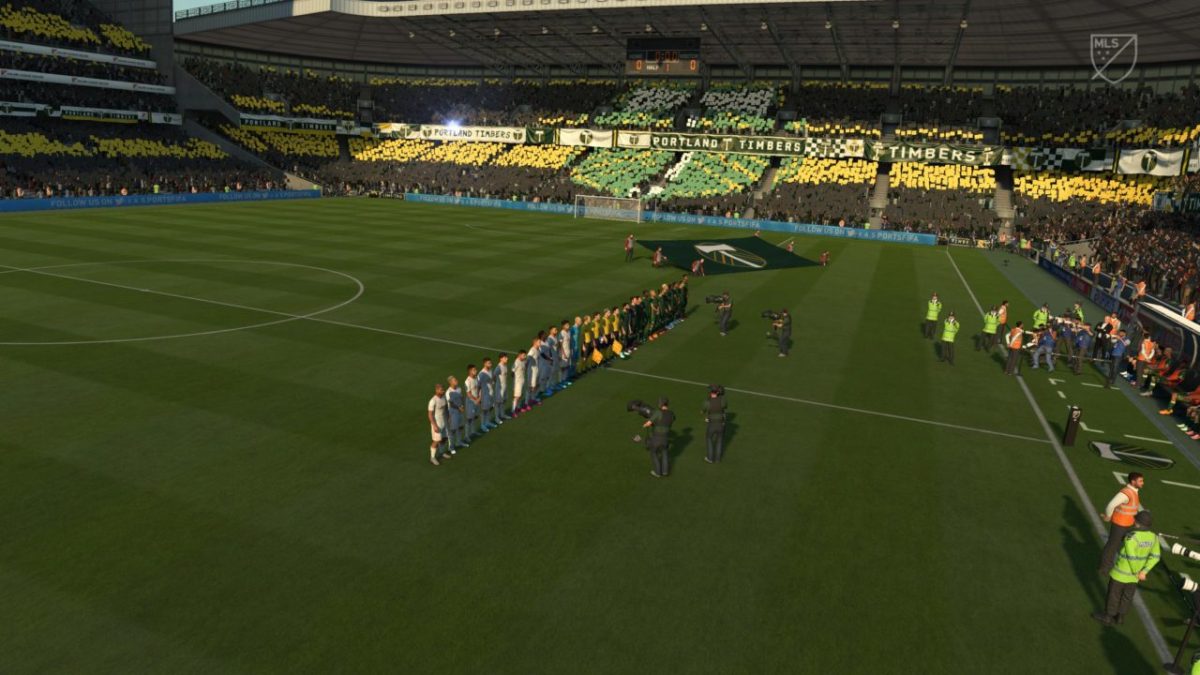
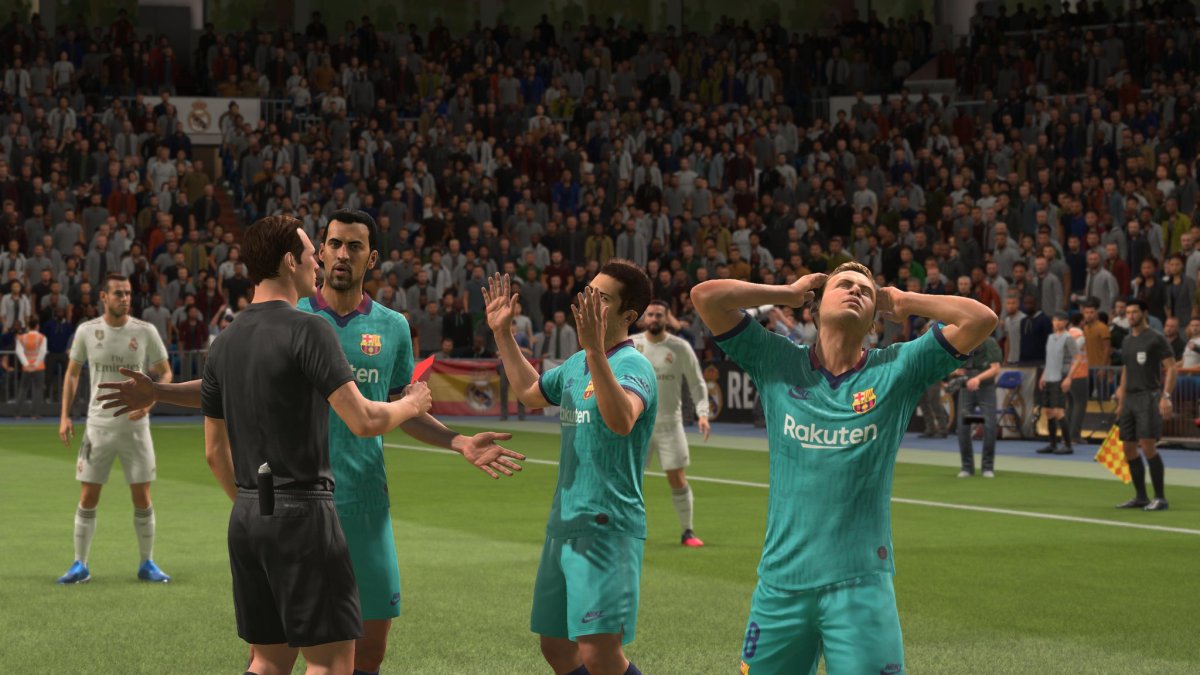
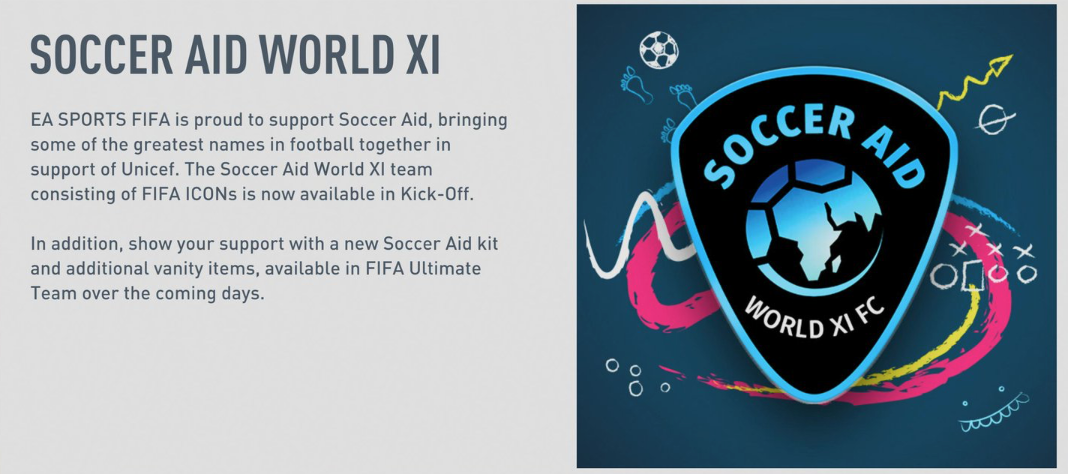
Published: Sep 23, 2019 04:19 pm